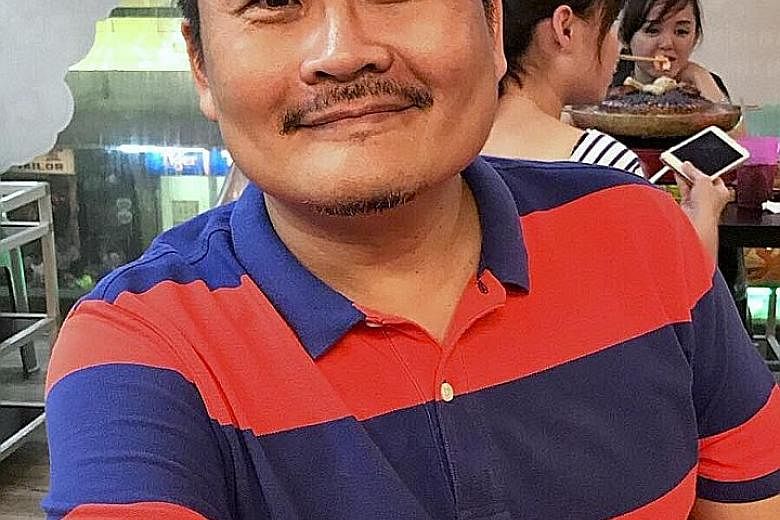Comic artist Otto Fong wants his books to inspire Asia's future science geniuses. That is why he explains complicated science with relatable local characters.
For instance, readers of his latest book may spot a reference to Hello Kitty in the character Hihi Pretty, a genetically modified cat that cannot eat because it has no mouth.
"You have to wrap new science in a familiar story," Mr Fong said. "Or else nobody would recognise what monstrosity you've created."
There are plenty of Asian elements in his latest work, Sir Fong's Adventures In Science Book 6: Synthetic Biology. In fact, the story's setting, Syn City, is almost directly lifted from a real life group: the National University of Singapore's (NUS) Synthetic Biology for Clinical and Technological Innovation (SynCTI).
Mr Fong, 49, said researchers from SynCTI approached him in late 2015 while he was completing his previous Sir Fong comic book on quantum physics.
"They feel that the future will be greatly changed by synthetic biology, and Hollywood has given it a bad name by presenting a dystopia in movies where mad scientists create horrible monsters by manipulating DNA," said Mr Fong. He said the scientists who approached him "are very eager to make sure the young generation are informed".
Synthetic biologists edit DNA, the basic building blocks of life, to improve organisms. This could involve putting genes from one organism into another. But the field is controversial, with critics raising issues like whether humans have the ethical right to change life so dramatically.

With funding from SynCTI, Mr Fong worked with 10 other South-east Asian artists to create the book. This also marks the first time his book is mostly illustrated by other people, and part of the reason lies in the book's theme.
"Synthetic biology is about taking the best features of one organism and putting them into another. This is like taking the talents of the artists and transplanting them into a story I write. So the more variation in their drawings the more refreshing it is."
Mr Fong has written five books in this science series over nine years, selling 20,000 copies in total.
But the former science teacher thinks he has not done enough. He wants his books to change Asian mindsets. He said: "I think Asians don't see science as embedded in our lives. We're all about catching up and doing well in our exams. Asians have proven we can do well in exams, so having conquered that summit, there must be something else we can do in science."
This is why he hopes to use his books to draw children between the ages of nine and 14 into complicated science. Learning the science from SynCTI researchers was a challenge even for Mr Fong. After that, he had to decide which ideas to put in his book. Knowing that synthetic biology is controversial, he wanted to take the debate to children in a way they could understand.
For example, some scientists want to bring extinct animals such as dinosaurs back to life, while others believe efforts should focus on protecting animals that may go extinct in our lifetime. Mr Fong illustrates this in his book by drawing out an argument between paleontologists Jack Horner, the scientist behind Jurassic Park, and Patricia Vickers-Rich. Other ethical issues, such as society's greed for new products, were also raised.
However, he does not give any "solutions" to the debates, allowing his young readers to form their own opinions. By embedding his lessons in a story with heroes and villains, and including elements that range from the whimsical (unicorns), the practical (super silkworms) to the dark (torturing animals for profit), he hopes to make this complicated topic easy to digest.
What is the next book going to be about? Mr Fong, who is a full-time comic-book writer, has no idea. But he is looking forward to the future, when the kids he hopefully inspires become leaders in science.
"In the next five to 10 years, when the students go into PhDs or become scientists or researchers, I'll wait for my Asian Einstein to say he was inspired by Sir Fong. But by then I'll be 60 years old!" he said.
Asked about Mr Fong's work, Professor Leo Tan, a marine biologist at NUS, said: "I believe that stories told in comic books could be educationally beneficial even as they entertain."
He said as science, technology, engineering, aesthetics and mathematics become the driving force for society's well-being, "Otto hit on a very appropriate vehicle - comic-book stories - to get our students to better appreciate and understand the importance of science for their future."
Said Prof Tan: "I hope he continues to produce more volumes to enlighten us on the mysteries of the universe."
Sir Fong's Adventures In Science Book 6: Synthetic Biology costs $18.90 with GST and is sold at Popular and Kinokuniya bookshops.






